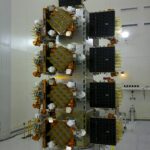
Civilian nuclear weapons programs at the Department of Energy will get almost all of the $3 billion raise the White House requested for fiscal year 2021, under the omnibus spending bill unveiled Monday. Both chambers of Congress were scheduled to vote on the measure Monday evening. The compromise spending package has some $19.7 billion for the DoE’s National Nuclear Security Administration (NNSA): nearly the $19.8 billion requested, over $3 billion above the 2020 appropriation of roughly $16.7 billion and around…

 By
By 










